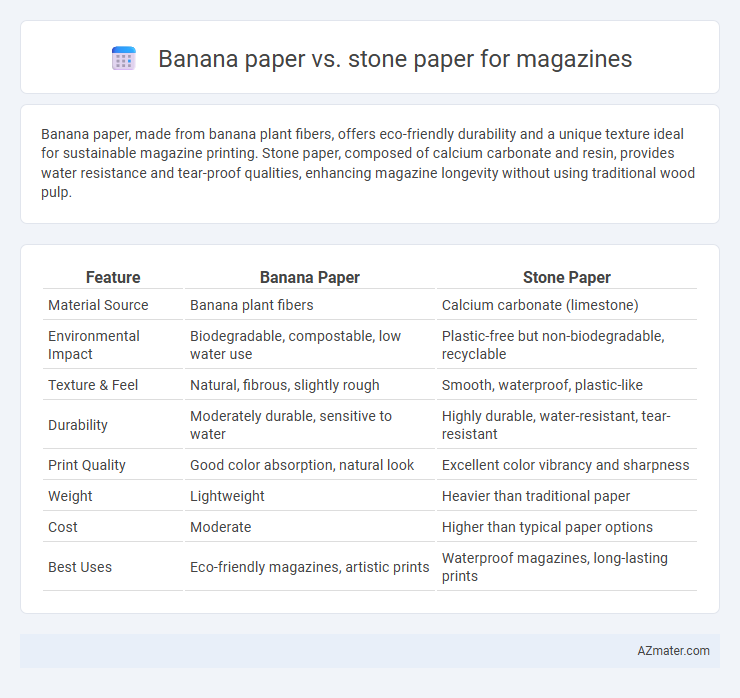Banana paper, made from banana plant fibers, offers eco-friendly durability and a unique texture ideal for sustainable magazine printing. Stone paper, composed of calcium carbonate and resin, provides water resistance and tear-proof qualities, enhancing magazine longevity without using traditional wood pulp.
Table of Comparison
| Feature | Banana Paper | Stone Paper |
|---|---|---|
| Material Source | Banana plant fibers | Calcium carbonate (limestone) |
| Environmental Impact | Biodegradable, compostable, low water use | Plastic-free but non-biodegradable, recyclable |
| Texture & Feel | Natural, fibrous, slightly rough | Smooth, waterproof, plastic-like |
| Durability | Moderately durable, sensitive to water | Highly durable, water-resistant, tear-resistant |
| Print Quality | Good color absorption, natural look | Excellent color vibrancy and sharpness |
| Weight | Lightweight | Heavier than traditional paper |
| Cost | Moderate | Higher than typical paper options |
| Best Uses | Eco-friendly magazines, artistic prints | Waterproof magazines, long-lasting prints |
Introduction to Banana Paper and Stone Paper
Banana paper, made from the fibers of banana plant waste, offers an eco-friendly alternative that reduces deforestation and promotes sustainable agriculture. Stone paper, produced from calcium carbonate bonded with non-toxic resin, is waterproof, tear-resistant, and highly durable, making it ideal for long-lasting magazine pages. Both materials present innovative solutions for environmentally conscious printing, with banana paper emphasizing biodegradability and stone paper highlighting durability and recyclability.
Material Composition: What Are Banana Paper and Stone Paper Made Of?
Banana paper is made from the fibers of discarded banana plants, utilizing agricultural waste to create an eco-friendly and biodegradable material. Stone paper consists primarily of calcium carbonate, a non-toxic mineral, combined with a small amount of high-density polyethylene (HDPE) resin, resulting in a durable, water-resistant, and recyclable alternative to traditional paper. Both materials offer sustainable solutions with unique compositions that cater to different environmental and functional needs in magazine production.
Environmental Impact: Sustainability and Eco-Friendliness
Banana paper, made from agro-waste such as banana stems, is highly sustainable due to its use of biodegradable materials and low water consumption during production, making it an eco-friendly alternative to traditional paper. Stone paper, created from calcium carbonate and non-toxic resin, reduces deforestation and water pollution but is non-biodegradable and challenging to recycle. Both options offer environmental benefits over conventional paper, with banana paper excelling in biodegradability and stone paper minimizing forest resource usage.
Manufacturing Processes Compared
Banana paper is produced by recycling banana plant fibers, which involves cleaning, boiling, and pulping the fibers before sheet formation, creating an eco-friendly product with minimal chemical use. Stone paper manufacturing utilizes calcium carbonate bonded with high-density polyethylene (HDPE), requiring no water or trees and incorporating extrusion and calendaring processes to form durable, waterproof sheets. The comparison highlights banana paper's reliance on natural plant fibers versus stone paper's synthetic composite approach, influencing environmental impact and recyclability.
Print Quality and Visual Appeal
Banana paper offers a unique texture and natural fiber appearance that enhances the print quality of magazines with vibrant, earthy tones and a tactile, organic feel. Stone paper provides a smooth, waterproof surface that delivers sharp, high-resolution images with a glossy finish, making visuals pop with exceptional clarity and durability. While banana paper appeals to eco-conscious readers seeking artisanal aesthetics, stone paper excels in delivering modern, sleek visuals with resistance to wear and tear.
Durability and Water Resistance
Banana paper offers moderate durability with natural fibers that resist tearing but can weaken when wet, making it less ideal for high-moisture environments. Stone paper boasts exceptional durability and water resistance due to its mineral-based composition, maintaining integrity and color even after prolonged exposure to water. For magazines requiring long-lasting, waterproof pages, stone paper provides superior performance compared to banana paper.
Cost Analysis: Affordability for Magazines
Banana paper generally offers a lower production cost compared to stone paper, making it a more affordable choice for magazines with tight budgets. Stone paper, made from calcium carbonate and resin, incurs higher manufacturing expenses despite its durability and waterproof properties. Magazines seeking cost-effective sustainability often favor banana paper due to its lower raw material and processing costs.
Weight and Texture Differences
Banana paper is lightweight and has a naturally fibrous texture that provides a rustic, organic feel, making it ideal for eco-friendly magazines seeking a tactile connection with readers. In contrast, stone paper is denser and smoother, offering a sleek, water-resistant surface that enhances print clarity and durability without adding bulk. These weight and texture differences significantly influence magazine design choices, balancing sustainability with aesthetic appeal.
Recycling and End-of-Life Disposal
Banana paper is biodegradable and compostable, breaking down naturally within months, making it an eco-friendly choice for magazine recycling and end-of-life disposal. Stone paper, composed primarily of calcium carbonate and resin, is recyclable but non-biodegradable, requiring specialized recycling facilities to prevent landfill accumulation. Choosing banana paper reduces environmental impact by minimizing plastic contamination and facilitating organic waste cycles.
Suitability for Magazine Publishing
Banana paper offers a sustainable and biodegradable option with a unique texture that enhances the tactile experience of magazines but may face challenges in ink absorption and durability. Stone paper provides water resistance, tear resistance, and smoother print quality, making it highly suitable for high-contrast images and vibrant colors in magazine publishing. Considering environmental impact and print quality, stone paper is better suited for glossy, high-end magazine formats, while banana paper fits niche eco-friendly publications.

Infographic: Banana paper vs Stone paper for Magazine
 azmater.com
azmater.com